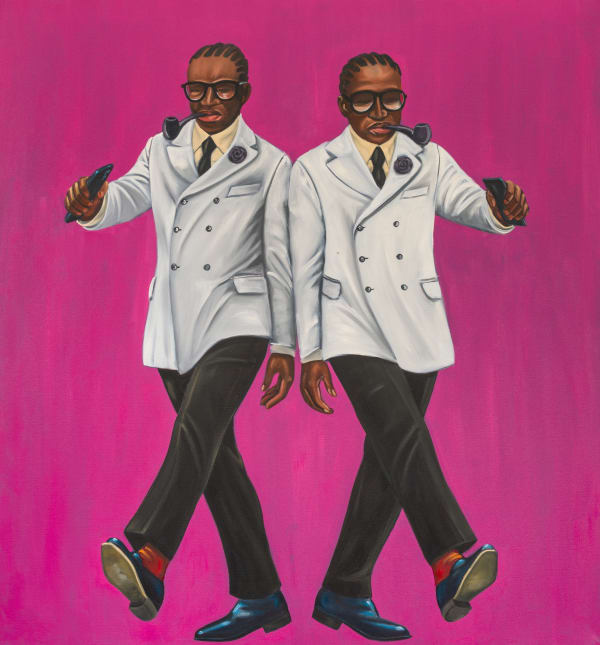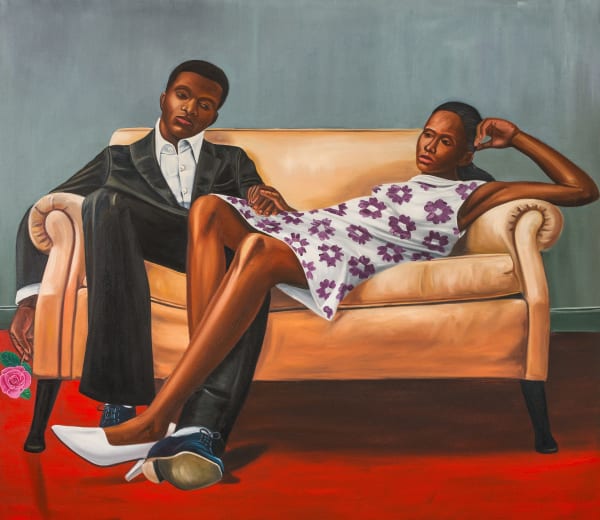-
-
Zemba Luzamba

-
-
Solo exhibitions include (Upcoming) Folk Ritual, Kristin Hjellegjerde Gallery, Berlin, Germany (2023-2024); Kitendi, Galerie Studer, Abidjan, Côte d’Ivoire (2023); TOTEM, EBONY/CURATED Cape Town, South Africa (2023); In the Name of…, Kristin Hjellegjerde Gallery, London, UK (2022); Connecxion, EBONY/CURATED Cape Town, South Africa (2019); Déjà vu at the 5th Picha Biennale de Lubumbashi, DR Congo (2017); In The South – Paintings from 2004-2017, Stellenbosch University Museum, South Africa (2017); Genesis, EBONY/CURATED, Franschhoek, South Africa (2016); It Is What It Is, EBONY/CURATED, Cape Town, South Africa (2015); LA SAPE, AVA Gallery, Cape Town, South Africa (2013); LA SAPE, AVA Gallery, Cape Town, South Africa (2012); Hope for Refugees, Rome, Italy (2005); Untitled, AVA Gallery, Cape Town, South Africa (2004).
-
Group exhibitions include Where the Wild Roses Grow, Kristin Hjellegjerde Gallery, Schloss Görne, Germany (2023); 'Print Co-Lab', Michaelis Galleries, Cape Town, South Africa (2023); Investec Cape Town Art Fair, EBONY/CURATED, South Africa (2023), If You Look Hard Enough, You Can See Our Future, African American Museum, Dallas, USA (2023); Tomorrow is Tomorrow is Tomorrow, Kristin Hjellegjerde Gallery, London, UK (2023); 'Untitled Miami Beach', with Kristin Hjellegjerde Gallery, Miami, USA (2022); When We See Us, A century of black figurative in painting, Zeitz Museum of Contemporary Art Africa, Capetown, South Africa (Zeitz MOCAA), South Africa (2022); Shout Plenty, the African Artists Foundation, Lagos, Nigeria (2022); AAGA annual African Galleries Now online edition powered by Artsy, Africa (2022); A Very Loop Street Summer, EBONY/CURATED, Cape Town, South Africa (2021); Everything Was Beautiful and Nothing Hurt, FNB Art Joburg, Open City, Keyes Art Mile, Rosebank, Johannesburg, South Africa (2021); 1-54 Contemporary African Art Fair, EBONY/CURATED booth, London, England (2021); 8 by 8, EBONY/CURATED, Cape Town, South Africa (2021); Investec Cape Town Art Fair, Virtual Representation, EBONY/CURATED, Cape Town, South Africa (2021); 1-54 Contemporary African Art Fair, (Virtual Representation) EBONY/CURATED, New York, US (2021)
-
-

-
-
Take, for instance, the painting Amandla in which a group of men stand in an arrow-shaped formation under an arch with their fists raised into the air. Amandla in the South African languages of Xhosa and Zulu means ‘power’ and was used as a rallying cry in resistance against apartheid while the raised fist is a universally recognised symbol of strength and solidarity. These days, however, both gestures are also used as a more informal expression of encouragement. ‘At weddings for example people might shout Amandla as a way of supporting the couple and showing them they are not alone,’ explains Luzamba.The suits that Luzamba’s characters wear similarly take on a double meaning. They are a uniform that again expresses solidarity and community, in this case, with the groom and are befitting of the formality and celebratory nature of the event. At the same time, they make reference a Congolese subculture known as SAPE (the Société des Ambianceurs et des Personnes Élégantes) that emerged in the 1960s and 70s when President Mobutu banned the wearing of Western-style style suits in favour of the abacost, a lightweight suit which was traditionally worn without a tie. The abacost was seen as the uniform of Mobutu’s supporters, especially those who had benefited from his regime. As such, the wearing of a suit and tie became a symbol of resistance and freedom. ‘It still has that association for me and for many Congolese,’ says Luzamba.
-
That sense of pride is perhaps most clearly expressed in the painting Boys will be Boys, which depicts the groom’s party wearing matching suits with pink ties and handkerchiefs, their heads turned towards the viewer with sombre expressions. As with all of the works in the series, Luzamba shies away from the stereotypical overblown wedding portraits of love and happiness to instead capture complex moments of apprehension, anxiety and even grief. Two Black Roses, for example, depicts the bride in-between two men – it is unclear which is the groom – each of whom is holding a black rose, traditionally a symbol not of celebration, but of death and mourning. ‘The roses represent the loss of the past and the uncertainty of the future. It is an acknowledgement that not everything is going to be easy or beautiful,’ Luzamba says. At the same time, the bride is not alone: her arms reach out to touch both men, creating a powerful pose of togetherness.In a sense this is what Folk Ritual is all about: the communal beliefs and practices – whether it be the simple ritual of drinking a pint with friends or raising a fist in the air – that provide us with the strength to overcome uncertainty.
-
-
-
Zemba Luzamba: Folk Ritual
Past viewing_room















